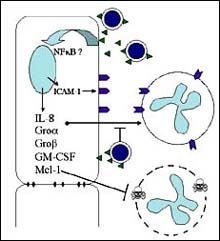UCSD Researchers Decipher Function Of Blood-Brain Barrier in Bacterial Meningitis

Schematic illustration of the blood-brain barrier response to the bacterium.Group B Streptococcus during newborn meningitis. Endothelial cells activate genes and produce protein factors that summon white blood cells to the brain to help fight the infection.
The first line of defense used by the human blood-brain barrier in response to bacterial meningitis is described by researchers at the University of California, San Diego (UCSD) School of Medicine in a study published in the September 2, 2003 issue of The Journal of Clinical Investigation. The scientists also describe two bacterial factors specific to the meningitis pathogen that thwart the normal protective role of the blood-brain barrier, leading to serious infection.
Composed of a layer of blood vessels called brain microvascular endothelial cells (BMEC), the blood-brain barrier separates the brain and its surrounding tissues from the circulating blood, tightly regulating the flow of nutrients and molecules and thereby maintaining the proper biochemical conditions for normal brain function.
Bacterial meningitis, a serious brain infection, can develop rapidly into a life-threatening infection even in previously healthy children or adults. Bacteria-producing meningitis enter the human bloodstream, are carried toward the brain, and somehow manage to cross the defensive line of the blood-brain barrier.
Using an experimental blood-brain barrier established by growing layers of human BMEC in tissue culture plates, the UCSD team observed that a specific set of 80 genes in the blood-brain barrier were activated when exposed to the pathogen Group B Streptococcus (GBS), the leading cause of bacterial meningitis in human newborn infants. These genes released proteins that mobilized human white blood cells called neutrophils, which are attracted to sites of infection.
Lead author Kelly Doran, Ph.D., assistant adjunct professor of pediatrics in the UCSD Division of Infectious Diseases, said “these findings demonstrate a novel function of the blood-brain barrier, to act as a sentry that detects the threat of a bacterial pathogen and responds by triggering an immune response to clear the infection.”
According to senior author Victor Nizet, M.D., associate professor of pediatrics, UCSD Division of Infectious Diseases and an attending physician at Children’s Hospital, San Diego, “the experiments also explain the basic mechanisms underlying the critical test used by physicians to make an early diagnosis of bacterial meningitis, namely the presence of abundant neutrophils in the fluid collected from the patient by the procedure known as a spinal tap.”
Although the blood-brain barrier effectively blocks the vast majority of circulating bacteria from entering the brain, its defensive function fails in bacterial meningitis infections. To understand how specific virulence properties of the GBS pathogen affect the blood-brain barrier immune response, the UCSD team developed mutant strains of GBS.
Hypothesizing that the capsule coating the surface of the GBS pathogen decreases the ability of the white blood cells and blood-brain barrier cells to recognize the bacteria as foreign, the researchers developed a GBS bacteria without a capsule. They discovered that the mutant was more easily recognized by the blood-brain barrier, which triggered a protective immune response.
“Thus, the role of the capsule is to cloak the bacteria, resulting in a weakened initial immune response that allows the pathogen to survive in the blood and produce an infection within the small blood vessels of the brain,” Nizet said. “It appears that the normal GBS with a capsule may represent a form of ‘molecular mimicry,’ where the bacteria disguises itself to look more like the host and avoid immune recognition.”
In a second test, the researchers developed a GBS mutant that lacked a potent cell-damaging toxin called beta-hemolysin/cytolysin. Mouse models infected with this mutant bacteria produced less meningitis than mice given normal GBS bacteria.
The researchers determined that after the GBS bacteria reach high concentrations in the blood-brain barrier, the action of the beta-hemolysin/cytolysin toxin injures the endothelial cells, breaks down the blood-brain barrier, and provokes the neutrophil inflammatory response that is the hallmark of bacterial meningitis. But by then it is too late as the bacteria are already entering the brain tissues. In fact, the activated neutrophils produce toxic compounds in an attempt to kill the bacteria, and these compounds also contribute to the brain injury of meningitis.
The UCSD team is continuing its studies to learn more about the role of pathogens in brain infection.
“We believe our ongoing studies of the interactions of the blood-brain barrier with bacterial pathogens will help uncover basic biologic principles that will lead to improved therapies for meningitis and other central nervous system infections,” Doran said.
George Liu, M.D., Ph.D., infectious diseases fellow, UCSD Department of Pediatrics, also contributed to the study. The work was funded by a Burroughs Wellcome Foundation Career Award to Doran, a Howard Hughes Medical Institute Postdoctoral Fellowship to Liu, an Edward J. Mallinckrodt Scholar Award to Nizet, the National Institutes of Health, and the United Cerebral Palsy Research Foundation.
News Media Contact:
Sue Pondrom
619-543-6163
spondrom@ucsd.edu
Media Contact
All latest news from the category: Health and Medicine
This subject area encompasses research and studies in the field of human medicine.
Among the wide-ranging list of topics covered here are anesthesiology, anatomy, surgery, human genetics, hygiene and environmental medicine, internal medicine, neurology, pharmacology, physiology, urology and dental medicine.
Newest articles

Breakthrough in magnetism that could transform quantum computing and superconductors
Researchers discover new magnetic and electronic properties in kagome magnet thin films. A discovery by Rice University physicists and collaborators is unlocking a new understanding of magnetism and electronic interactions…

NASA to launch innovative solar coronagraph to Space Station
NASA’s Coronal Diagnostic Experiment (CODEX) is ready to launch to the International Space Station to reveal new details about the solar wind including its origin and its evolution. Launching in…

Boosting efficiency in mining with AI and automation
“Doing instead of procrastinating”. This is the AI strategy presented by Prof. Constantin Haefner, Director of the Fraunhofer Institute for Laser Technology ILT, at the “AKL’24 – International Laser Technology…



